Backlash over NHS’s 5-step recovery blueprint to avert another devastating winter crisis
>
A five-point plan that NHS bosses hope will boost capacity and keep more patients out of hospital is unachievable while the health service is ‘haemorrhaging’ staff, top medics warned today.
The blueprint, backed by the Prime Minister, is expected to ease pressure on the NHS in England and avert another winter crisis by boosting capacity, hiring more medics and speeding up discharges.
It details plans for an extra 5,000 hospital beds, 800 ambulances and 3,000 virtual wards — which sees sick Brits cared for in their own homes — to free up beds and reduce waiting times.
But experts warned that even though the plan contains ‘sensible’ ambitions, it ‘will not work’ in averting another ‘dangerous crisis’ in the health service without more staff.
The blueprint, backed by the Prime Minister (right), is expected to ease pressure on the NHS and avert another winter crisis by boosting capacity, hiring more medics and speeding up discharges
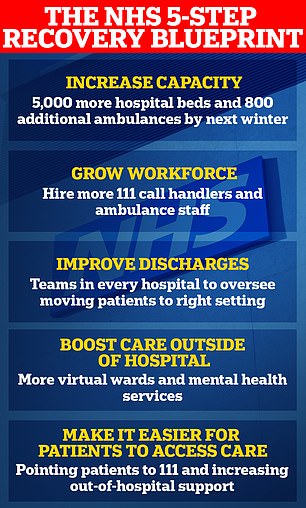
The NHS recovery plan sets out ambitions to boost NHS capacity.
A lack of space in hospitals has been blamed for patients wait days in emergency departments before being given a bed this winter.
It has also had a knock-on effect on ambulance response times, as 999 crews have been forced to queue outside of hospitals until a space becomes available for their patient — rather than responding to new emergency callers.
In a bid to tackle this, the NHS has been told to boost capacity.
It will get an extra £1billion to increase space in hospital, including 5,000 new beds by next winter.
More than 800 ambulances will be on the road within the next year, including 100 specialist mental health ambulances, according to the plan.
And ‘same day’ emergency care services will be available at all major A&E departments to slash overnight waits among emergency patients.
The health service plans to grow the workforce.
It will hire more ambulance staff and 111 call handlers, with the latter, in part, being older medics who are convinced through ‘targeted campaigns’ to keep working in the health service rather than retire.
Flexible working will be offered to more NHS staff to boost retention and new hires.
The third arm of the plan details how discharges from hospital will be sped up to reduce the number of beds taken up by those who are fit to leave — known as bed blockers.
Some £1.6billion of NHS funding over the next two years will be ring-fenced for getting patients out of hospital.
This will go towards creating ‘care transfer hubs’ in every hospital by winter so people don’t stay in hospital longer than necessary.
Under plans to increase NHS services in the community, there will be a great use of ‘virtual wards’ to monitor patients — such as those with long-term conditions, frailty or respiratory infections — from home.
The approach involves using apps, technology platforms, wearables and pulse oximeters to check patients condition while they are outside of hospital.
Health chiefs will include an extra 3,000 beds in patients’ homes as part of its virtual bed count, bringing the total to 10,000 by the autumn. Officials hope 50,000 patients per month will be treated outside of hospital by March 2024.
As part of a scheme to get Brits to access ‘the right care first time’, the NHS will continue to encourage patients to call 111 as the ‘first port of call’ to reduce the numbers showing up at A&E.
It will also make mental health support available to everyone through the 111 service.
The plan sets out that despite the ‘best efforts’ of the health service, discharge delays, the twin-demic of Covid and flu as well as record bed occupancy levels has caused patient flow through hospitals to be slow this winter.
On top of these five points, the document sets out ambitions for patients to be seen faster in emergency departments.
Around three-quarters (76 per cent) of A&E attendees in England should be admitted, transferred or discharged within four hours by March 2024, it states.
The figure is far short of the 95 per cent target set out in the health service’s own handbook. But it is higher than the 65 per cent figure logged in December.
The plan also sets out that paramedics should reach category two 999 callers — which includes heart attack, strokes, burns and epilepsy victims — within 30 minutes, on average, from March 2023.
There should be ‘further improvement’ towards pre-pandemic levels from March 2024. For context, the average response time in December was more than 90 minutes, compared to around 20 minutes before Covid struck.
On a visit to County Durham today, Rishi Sunak said: ‘I think we will see — in fact I know we will see — the largest and fastest-ever improvement in emergency waiting times in the NHS’s history.
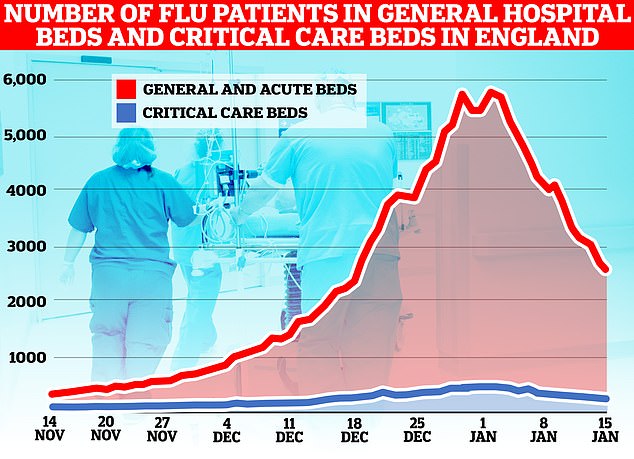
The number of flu patients taking up hospital beds has been trending downwards for a fortnight after peaking at 5,779 on January 2. Latest data, for the week to January 15, shows 3,447 people infected with influenza were in hospital per day, on average, last week. The figure is 35 per cent lower than the 5,262 figure one week earlier

NHS England data shows that ambulance handover delays have fallen to their lowest level this winter. Less than one in four (23 per cent) ambulance patients waited 30 minutes or longer last week before be handed to A&E teams, down from 36 per cent one week earlier (red line)
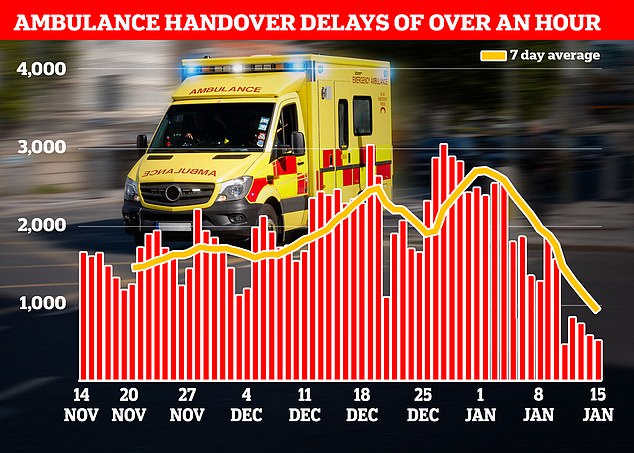
Just one in 10 ambulance patients (nine per cent) waited more than one hour to be handed over to A&E teams — another record low this winter down from 19 per cent in the previous week
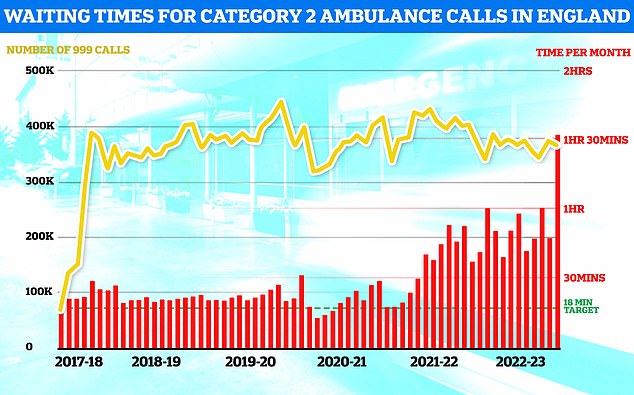
NHS ambulance data for December shows that 999 callers classed as category two — which includes heart attacks, strokes, burns and epilepsy — waited 1 hour, 32 minutes and 54 seconds, on average, for paramedics to arrive (shown in red bar). This is five-times longer than the 18 minute target (shown in green line). This is despite category 2 cases falling slightly to 368,042 (shown in yellow bar)
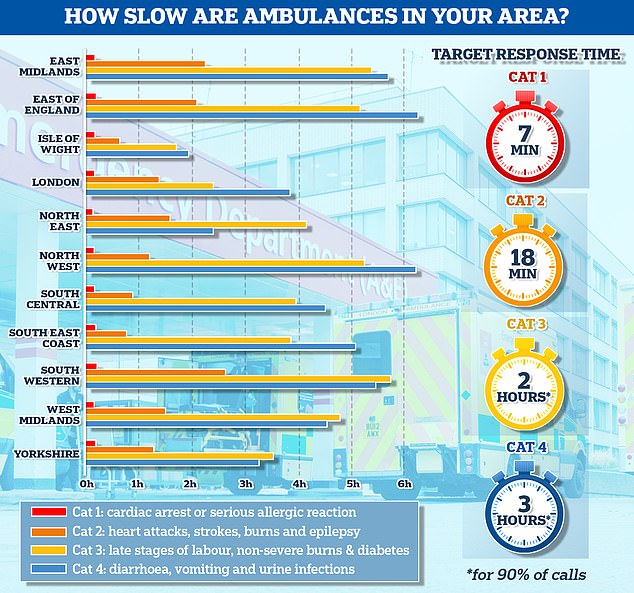
The graph shows the average response times for each category of 999 calls across 11 parts of England. The South West logged the slowest response time for both category one and category two calls, taking 13 minutes and 11 seconds and 2 hours and 29 minutes on average, respectively
He said: ‘That is the ambition of our plan that we’ve set out today. I feel really confident we can deliver it.
‘We’re going to improve things for patients and make an enormous difference to people up and down the country.’
However, Dr Tim Cooksley, president of the Society for Acute Medicine, said the plans ‘will not work’ without more staff.
He told ITV’s Good Morning Britain: ‘We’ve had an unbearable winter with appalling conditions for staff and patients.
‘The fundamental problem for that has been a significant shortage in workforce, leading to a lack of beds and capacity within urgent and emergency care and throughout the NHS.’
While there is some ‘extremely positive’ parts to the plan, it cannot be achieved without ‘a people recovery’, Dr Cooksley said.
He added: ‘There isn’t the workforce to currently deliver this and that is the major concern.
‘We have this significant workforce shortage, and we are haemorrhaging staff and unless we have some clear retention plans, and some clear plans to attract colleagues back who have left, alongside recruitment plans, this plan will not work.’
Saffron Cordery, interim chief executive of NHS Providers, said the plan is an ‘important step forward’ in tackling the ongoing ‘very serious challenges’ facing the NHS.
But she told BBC Radio 4’s Today programme that there ‘are some big questions about where the workforce will be coming from’.
All eyes will now be on the Budget to determine whether the plan will be fully funded — as without extra medics, any additional capacity cannot be safely staffed, Ms Cordery said.
Dr Adrian Boyle, president of the Royal College of Emergency Medicine, said the plan is ‘sensible’.
Dr Boyle, who previously warned that the crisis in emergency care was killing up to 500 patients every week, said the situation ‘must never’ be allowed to happen again.
He told Times Radio: ‘There was such a significant, dangerous crisis in all of our urgent and emergency care system, that if people don’t start doing the good principles in this plan, will be holding them to account about it.
‘As always, the problem with these plans is how it gets implemented, and we’ll be watching that really closely.’
Dr Boyle added: ‘Retention is a big part of this — you can recruit as many junior nurses and doctors as you’d like, but if you haven’t got the senior people to look after them and develop them, it’s actually quite difficult to get much out of them.’
Sara Gorton, head of health at the UNISON union, said the PM must ‘resolve the workforce crisis happening now’ before taking credit for ‘fixing emergency care next winter’.
There are no plans to stop staff leaving the NHS or resolve ongoing strikes among nurses, ambulance staff and physiotherapists, she noted.
Ms Gorton said: ‘Without halting further strikes over pay and staffing, it’s difficult to see how this plan will be delivered. Particularly with precious little new funding from the Treasury.
‘The success of the NHS begins and ends with its employees. No plans to deal with waiting times and handover delays stand a chance without tackling staffing shortages.’
